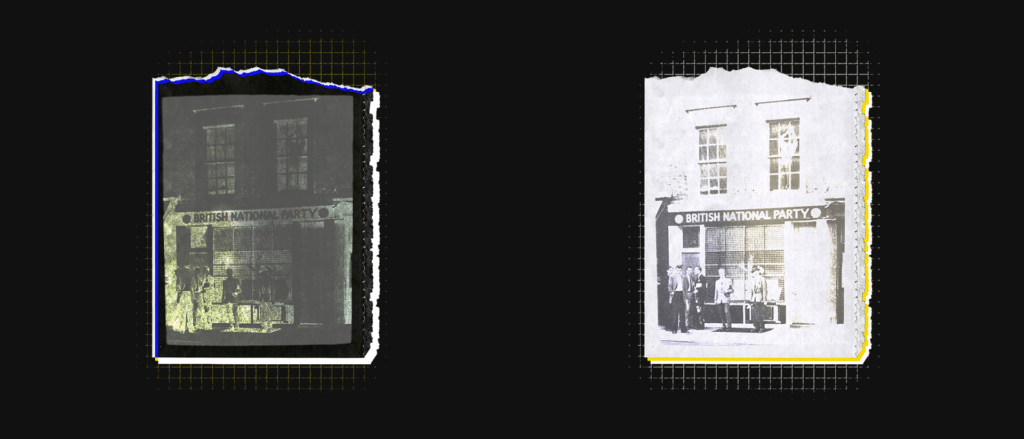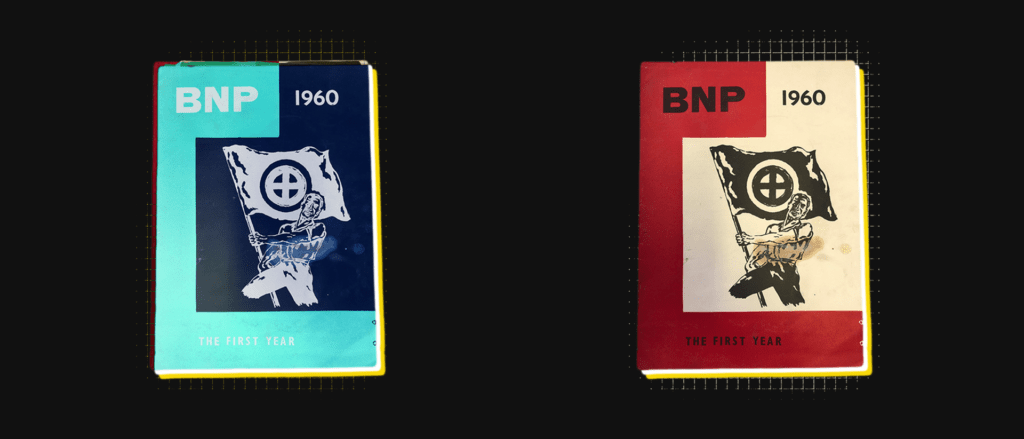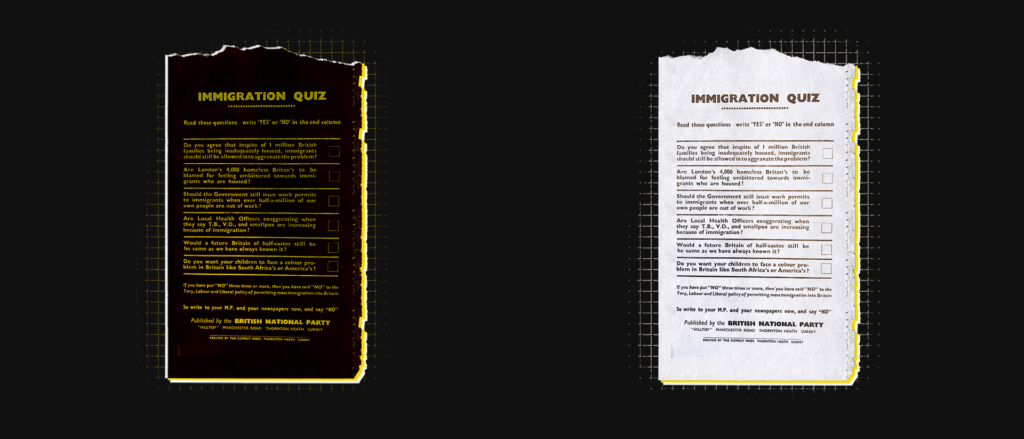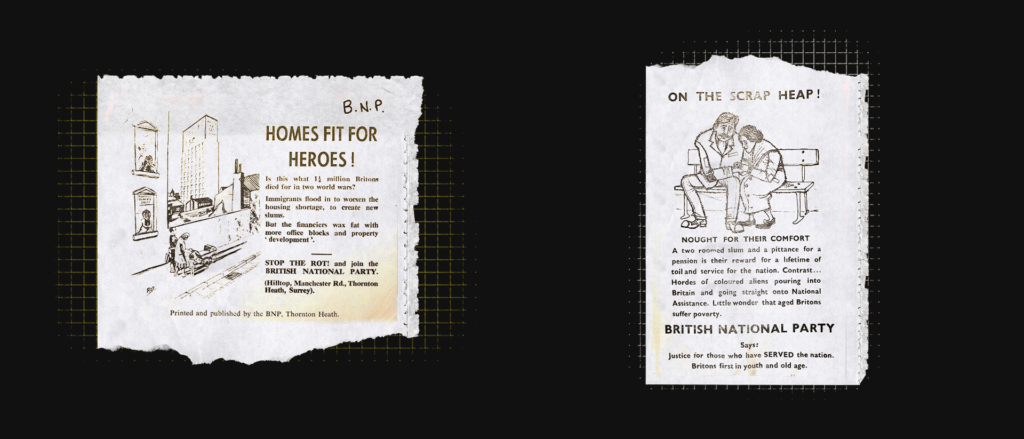HOPE not hate uses cookies to collect information and give you a more personalised experience on our site. You can find more information in our privacy policy. To agree to this, please click accept.
In “Heroes and Villains”, the classic 1996 episode of Only Fools and Horses, Del Boy and Rodney are sat in a café as Trigger proudly explains the reason for his new award from the council, where he works as a road sweeper. “So what exactly is the award for?” asks, Rodney. “For saving the council money […] I’ve had the same broom for the last twenty years,” responds Trigger. “This old broom has had 17 new heads and 14 new handles in its time”. Unwittingly he was actually touching on one of the oldest thought experiments in Western philosophy, the so-called ship of Theseus, which raises the question of whether an object that has had every component replaced remains fundamentally the same object. When it comes to the history of the postwar British far right, the answer is an emphatic yes. While the people and groups have almost all changed, the politics of hatred and division they espouse remains the same.
This summer the far right have engaged in an ugly and confrontational anti-migrant and anti-asylum seeker campaign targeted at cross channel arrivals. Numerous demonstrations, including those in Dover and Nottingham, as well as a series of videos by Nigel Farage and Britain First at hotels housing recent arrivals, have whipped sections of the far right into a peak of anger around the issue.
It has probably not been since the early 2000s that the far right have focused so much time and effort on the issues of migration and immigration, with Islam and Muslims having been the primary focus for the last decade. However, what is striking about this recent spate of anti-immigrant activity is how similar it is to previous waves of far-right hostility towards recent arrivals. For this reason, I delved back into the HOPE not hate archive and dusted off a box of material related to a long dead British far-right group called the British National Party (BNP).
Unconnected to the BNP we know today, this party was formed on 27 February 1960, with the merger of John Bean’s National Labour Party and Colin Jordan’s White Defence League. In their own words, it was the merger of two groups, “who in the short space of eighteen months had repeatedly burst into the Press headlines with their stand against the Black invasion of Britain and the betrayal of our White Kinsmen overseas, merged together in one united body for race and nation. The British National Party was born.”[i]

The group were based out of 74 Princedale Road in West London, a terraced house previously owned by the infamous British fascist Arnold Leese and later handed down to Colin Jordan. While only a small operation that was eventually subsumed by the National Front in 1967, the BNP remains an interesting groupuscule in the history of the British far right. It sat at a crossroads for the movement in which, despite antisemitism remaining at its core, anti-immigrant and anti-black racism began to take centre stage.
There are of course huge differences between 1960 and today, not least that the arrivals to Britain in the 1950s were not asylum seekers as many are today. Moreover, societal attitudes to race and immigration have improved since the early postwar period. However, as this box of archival material from the period shows, the reaction of the far right to the arrival of non-white people on our shores then was staggeringly similar to what we have witnessed from the contemporary far right this summer.
A Tolerant Country? Immigration in the 1950s[ii]
The 1948 Nationality Act gave all imperial subjects the right of free entry into postwar Britain. However, due to the financial hurdle of paying for passage via boat, the immigration from the West Indies that started in 1947 remained a trickle for the first few years. By the mid-1950s this changed with steadily increasing numbers making the voyage. In 1954, 24,000 people arrived, followed by 26,000 the year after meaning that by 1958 some 115,000 people had left the port of Kingston and Port of Spain and arrived in Britain to make a new life.[iii]
West Indians were not alone in making the journey to the imperial capital. Many thousands came from India and Pakistan, often as a result of the problems caused by partition. Sikhs, Hindus, Muslims and as many as 30,000 Anglo-Indians also made the journey to join their fellow colonial subjects,[iv] bringing the total to nearly a quarter of a million empire and commonwealth immigrants in the decade following the arrival of Windrush.[v]
Obviously, reactions to the arrival of non-white immigrants varied extensively depending on location and socio-economic environments and some early arrivals mentioned how communists tried to befriend them as soon as they landed in Britain.[vi] However, there is certainly evidence to provide a serious challenge to the myth of British tolerance and friendliness. Far more pervasive than overtly physical manifestations of racism was the more day-to-day prejudice and discrimination faced by new non-white immigrants with many struggling to find employment, accommodation and social acceptance.
Perhaps the most poetic and articulate deconstruction of the myth that immigrants have always received a warm welcome in Britain came via a fictional account of West Indian immigrants in 1950s London. Sam Selvon, a Trinidadian author and an immigrant to Britain himself, penned the classic 1956 novel The Lonely Londoners. It details the lives of West Indian immigrants in 1950s London as they experience the failed promise of the ‘mother country’, the hostility of the locals and the struggles to build new lives, all coupled with the heady excitement of being in a city they had read and dreamt about. While Moses, the main protagonist, mentions a modicum of tolerance – ‘It have a kind of communal feeling with the working class and the spades, because when you poor things does level out’[vii] – the overwhelming reaction is portrayed as hostile and deeply racist. The following passage from the novel, a discussion between Moses and Galahad, a new immigrant arrival, is worth quoting at some length as it successfully shows up the racism and hypocrisy that lies just beneath the myth of tolerance.
‘These days, spades all over the place, and every ship load is big news, and the English people don’t like the boys coming to England to work and live’.
“Why is that?” Galahad ask.
“Well, as far as I could figure, they frighten that we get job in front of them, though that does never happen. The other thing is that they just don’t like black people, and don’t ask me why […]”.[viii]
Such accounts are common, with hypocrisy often being highlighted in West Indian descriptions of their perceptions of their new home. The sad truth is that often the reactions to the birth of non-white immigration to the UK, both official and popular, lacked the humanity and civility to justify the national myth of tolerance so often trotted out.
Far-Right Reaction
Throughout the 1950s the Holocaust continued to loom over the far right, making even nominal public support beyond their reach. Yet the arrival of non-white immigrants, and the subsequent racist societal backlash, offered a glimmer of hope to the postwar far right. However, while the issue certainly became a more central tenet of their prejudiced politics as the 1950s progressed, it didn’t happen as quickly as one might have presumed.
In contrast to the howls of disapproval from far-right parties today in response to the arrival of every new immigrant, black or white, it is quite remarkable that Union, the newspaper of Oswald Mosley’s postwar Union Movement, passed no comment at all on the arrival of Windrush. At the time, most of the British far right remained preoccupied with antisemitism. However, from 1955 onwards, anti-‘coloured’ rhetoric ascended to become the primary issue for the British far right. A shift exemplified by the decision to move the Union Movement’s operations from the Jewish areas of East and North London to the new immigrant areas in the South and West of the city.[ix]
What this indicates is that rather than the far right driving societal hostility towards new arrivals, they were actually seeking to gain political capital by responding to societal hostility. Sadly, it was not long before this prejudice turned to violence. In 1958, as a balmy summer drew to a close, Britain saw some of the worst racial violence it has ever witnessed, as riots exploded on the streets of Nottingham first and then in Notting Hill in West London. However, while the worst, this was by no means the first example of racial violence experienced by non-white immigrants. There had been anti-black rioting in Liverpool from 31 July to 2 August 1948 and further riots in Deptford, London, in July 1949. The homes of Indian workers near Birmingham were also attacked in August of 1949.[x] Inter-racial violence broke out again in London in August 1954 with disturbances in Camden Town, when a white mob attacked black people with bottles, axes and a petrol bomb that burned out the home of a black resident.[xi] These racially motivated attacks were all overshadowed by the major riots of 1958.
The Notting Hill Riots serve to reiterate the point that the far right were not extremist outliers on the issue of race, immigration and “miscegenation” in the immediate postwar period. While their language was often (though not always) more visceral and base, their interest more obsessive and their recommended solutions often more extreme, the British far right were echoing the views of large proportions of the wider general public.
The British National Party

It was at this moment of growing societal hostility towards immigration that a new far-right party emerged on the scene, the British National Party (BNP). Formed in 1960 it had only grown to a membership of around 1,000 by the time it was subsumed into the National Front in 1967.[xii] The groups ideology was based on a combination of racial nationalism and virulent antisemitism, and called for a halt to all immigration and repatriation of existing non-white residents in the UK.
Despite being an amalgamation of several pre-existing fascist groups, the unity was fleeting, with Colin Jordan’s increasingly overt Nazism resulting in him splitting away in 1962 to form the National Socialist Movement with future National Front leader John Tyndall. This left the BNP in the hands of John Bean, a fascist whose activism continued until as recently as 2013. Over the years, the group sought to exploit tensions around non-white immigration which they did with some success, using the issue to break out of the post-Holocaust isolation in which the fascist scene had found itself since the war.
Within the HOPE not hate archive is a box of BNP material including leaflets, most of which are about the issue of immigration. Despite being from 60 years ago, many of them look indistinguishable from the propaganda pushed out this year by groups like Patriotic Alternative.
One leaflet touches on a whole series of tropes still used by the contemporary far right, namely that immigrants and asylum seekers take jobs, use up housing and even spread disease. “Do you agree that in spite of 1 million British families being inadequately housed, immigrants should still be allowed in to aggravate the problem?” read one question. “Should the Government still issue work permits to immigrants when over half-a-million of our own people are out of work?” another. And in a language reminiscent of the modern far right’s claims that immigrants are spreading Covid-19, the leaflet asks: “Are Local Health Officers exaggerating when they say T.B., V.D., and smallpox are increasing because of immigration?”

As well as blaming immigrants for job and housing shortages in general, this summer has seen the British far right frame the arrival of new asylum seekers as the primary cause of homelessness amongst British war veterans. Whether it was the far-right demonstration in Dover in September or Britain First’s storming of hotels housing asylum seekers, wrapping their anti-immigrant politics in the veil of support for veterans has been a key narrative for the far right this year. As Paul Golding, leader of Britain First, put it in a recent video inside the kitchens of a hotel accommodating asylum seekers: “Well here you go, here’s all the food for the asylum seekers. If only they looked after our homeless veterans with this much food.”
Once again, this tactic is by no means new. In the 1960s the BNP produced a series of leaflets that are strikingly similar in tone and style, portraying support for new arrivals as happening at the expense of veterans. “Is this what 1 ¼ million Britons died for in two world wars? Immigrants flood in to worsen the housing shortage, to create new slums” read one leaflet while another stated, “On The Scrap Heap! Nought for their comfort. A two roomed slum and a pittance for a pension is their reward for a lifetime of toil and service for the nation. Contrast … Hordes of coloured aliens pouring into Britain and going straight onto National Assistance.”

Another element of contemporary far-right rhetoric is the claim that any attempt to speak out against immigration or asylum seekers is shut down by political correctness. In recent years the idea that free speech is being curtailed and debate stifled has become one of the key campaign points for the far right. Unsurprisingly however, this is also nothing new. Back in the 1960s the BNP also produced a series of leaflets and articles that lamented their supposed lack of free speech. In rhetoric that could have come straight from one of the far right organised free speech demonstrations in recent years, the BNP-linked publication, The Nationalist, carried an article in March 1960 in response to the proposal of a new Racial and Religious Insults Bill:
“So it boils down to this. In the name of “Democracy,” Britons in their own country are going to be faced with either or both a fine and imprisonment if they dare say anything […] against the Jewish and coloured intruders, and in favour [of] Britain belonging to the British. There is going to be all the free speech in the world for all those engaged in attacking the heritage of our race and nation, and none at all for those who wish to see that the land and work of our ancestors remains the property of their descendants.”[xiii]
Similarly, in 1963 after the withdrawal of permission to hold a meeting at a Council-run location they produced a leaflet that read:
“Communists, Socialists, Liberals, Conservatives and even the Indian Workers Association, are all allowed to hire halls, such as Shackleton Hall, from the local Council for public meetings. YET THE BASIC RIGHT OF FREE SPEECH IS DENIED TO THE BRITISH NATIONAL PARTY. […] Whatever your political views, is this justice? Is this democracy? […] OBVIOUSLY SOME PEOPLE ARE AFRAID OF WHAT WE HAVE TO SAY.”[xiv]
What
this box of BNP literature from the 1960s makes clear is that while the people
and groups, and in recent decades the means of distribution and activism,
change with time, the core rhetoric of the British far right often remains the
same. None of this is to say that all far-right groups are the same or that
there are never changes, there clearly are, but there are also striking
continuities in British racist discourse. In some ways this is comforting, to
realise that that fascist and far right groups have long sought to whip up
anti-immigrant sentiment but all have failed to halt Britain’s continued journey
towards becoming a country more welcoming to diversity. In other ways it is
disheartening, to realise how little some things have changed. The British far
right might have had 17 new heads and 14 new handles, but at its core, it
remains the same broom.
[i] BNP: The First Year (London: Combat Press, 1960), 1.
[ii] Parts of this section are taken from: Joe Mulhall, British Fascism After the Holocaust: From the Birth of Denial to the Notting Hill Riots 1939-1958 (London: Routledge, 2020).
[iii] Numbers from: Robert Winder, Bloody Foreigners: The Story of Immigration to Britain (London: Little Brown, 2004),270.
[iv] Winder, Bloody Foreigners, 272.
[v] Winder, Bloody Foreigners, 265.
[vi] Mike Phillips and Trevor Phillips, Windrush: The Irresistable Rise of Multi-racial Britain (London: Harper Collins, 1999), 85.
[vii] Sam Selvon, The Lonely Londoners (London: Penguin Books, 2006) (First published Alan Wingate, 1956), 61.
[viii] Selvon, The Lonely Londoners, 20-21.
[ix] Richard Thurlow, Fascism in Britain: From Oswald Mosley’s Blackshirts to the National Front (London: I.B. Tauris, 2009),216.
[x] Layton-Henry, The Politics of Immigration: Race and Race Relations in Postwar Britain (London: Wiley-Blackwell, 1992), 37.
[xi] Dilip Hiro, Black British White British: A History of Race Relations in Britain (London: Grafton Books, 1992), 36.
[xii] Thurlow, Fascism in Britain, 231.
[xiii] ‘The Jewish Threat To Freedom’, The Nationalist, No.4, March 1960, 1.
[xiv] ‘Freedom of Speech – But Not In Southall!’, Leaflet.

Right-wing comic Kearse saves the worst material for his anonymous Telegram account HOPE not hate has identified an anonymised Telegram account belonging to the GB…